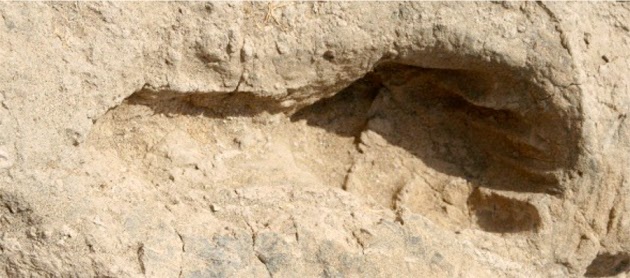
A long-past hunting party left a permanent sign of its outing — and it was not empty beer cans. Dozens of 1.5-million-year-old human footprints in Kenya may be evidence of an early antelope hunt, offering a rare look at the lives of ancient humans, researchers reported at a conference in California this week.
Footprints are the rarest of human relics. They tend to erode away very quickly; only the choicest of conditions keep them preserved for thousands or millions of years. But unlike collections of bones and tools — which are difficult to link to a single individual or group — footprints offer a snapshot of daily life.
In the late 2000s, researchers exploring the area near a village in northwestern Kenya, called Ileret, for human bones and tools instead stumbled on a collection of 22 human footprints. Their 2009 publication on the discovery, in Science1, focused on the anatomy of the people who left the prints: tall individuals who probably belonged to the species Homo erectus, and who walked very much like modern humans (Homo sapiens).
But Neil Roach, a palaeoanthropologist at the American Museum of Natural History in New York, saw the prints as an opportunity to catch a glimpse in the day of a life of Homo erectus. He and his colleagues returned to Ileret to take a closer look at the prints and to search for more.
They have now found around 100 human footprints, split between several sets that were probably each laid down on the same day. Roach says that the prints represent groups of multiple individuals, rather than lone ramblers. The size of the prints point to adult males, he told the annual meeting of the Paleoanthropology Society in San Francisco.
One direction
To get a better sense of the purpose of these jaunts, Roach and his colleagues looked at the prints of other animals, including crocodiles, antelopes and other bovids, and birds such as storks and pelicans. This mix suggests that the ancient humans were walking on a lakeside buffered by grasslands, Roach says. And unlike the grass-eating bovids, whose prints tended to lead from the grasslands to the lake shore, the humans all walked in one direction along the lake — similar to the movements of other hunting animals.
Roach and his team propose that the tracks represent group hunts for antelope or wildebeest. “What we can say is that we have a number of individuals, probably males, that are moving across a lake shore in a way that is consistent with how carnivores move,” he says. The researchers now plan to study the movement patterns of present-day subsistence hunters in Africa to get a better idea of what their footprints look like. “Hunting is a difficult thing to prove in human evolution,” Roach says. The presence of numerous adult males also points to some level of cooperation.
Other evidence suggests that Homo erectus — a forebear to modern Homo sapiens — were more predatory than their ancestors, who may have scavenged the meat that they ate. Stone tools and cut-marked bones become more common in the archaeological record after around 2 million years ago (when Homo erectus emerged). And some researchers have speculated that their svelte bodies helped them to track down fast-moving prey, while their bulging brains demanded loads of calories. “There’s starting to be a consensus that around 2 million years ago we see more carnivory that has to do with hunting,” Roach says.
“Who knows what they’re doing there,” says Curtis Marean, a palaeoanthropologist at Arizona State University in Tempe. “It could be a group hunt, but it could also be lakeshore foraging.” Some lakeshore plants produce nutritious bulbs on which the footprint-makers may have gorged.
But Marean thinks that Roach and his team are onto something by using footprints to study daily life. “It’s a completely novel piece of data,” he says. “I think it’s a really interesting way to get an angle on what communities were doing in the past.”
Note : The above story is based on materials provided by Nature










